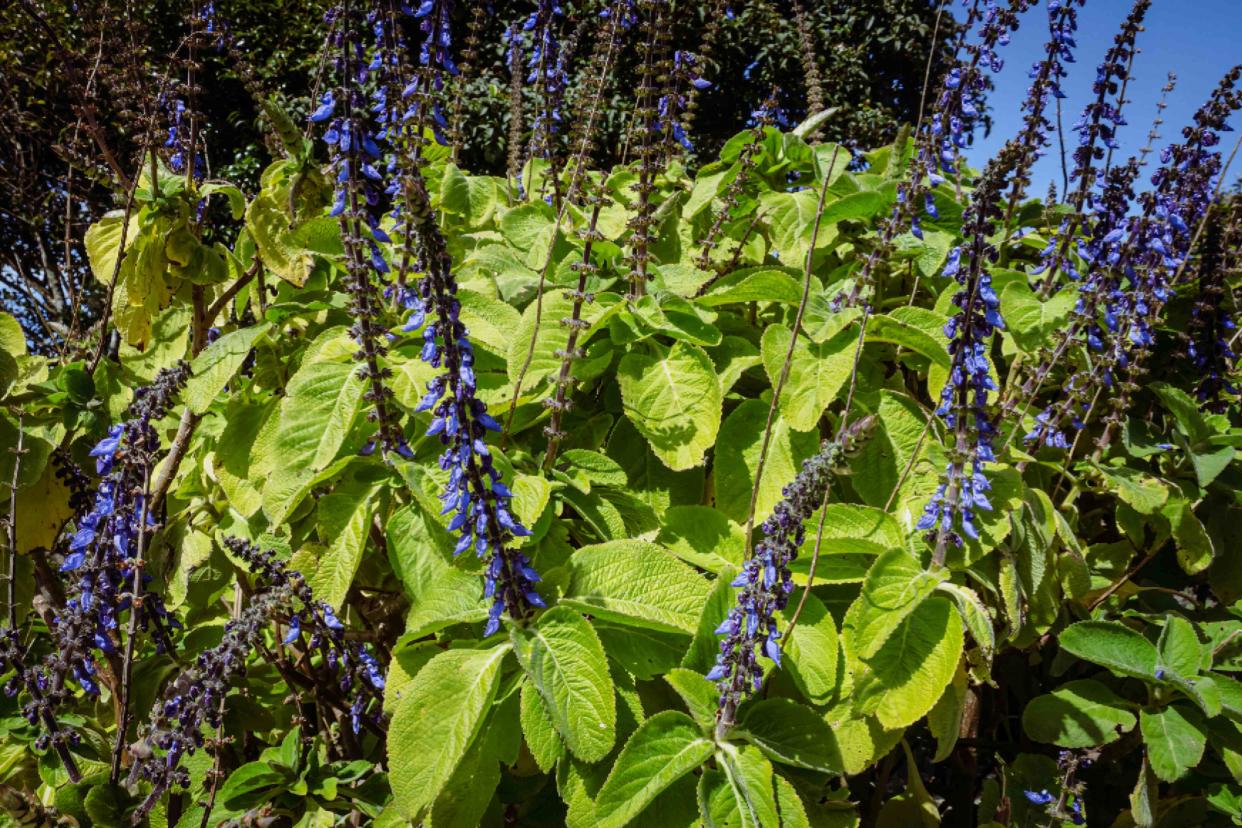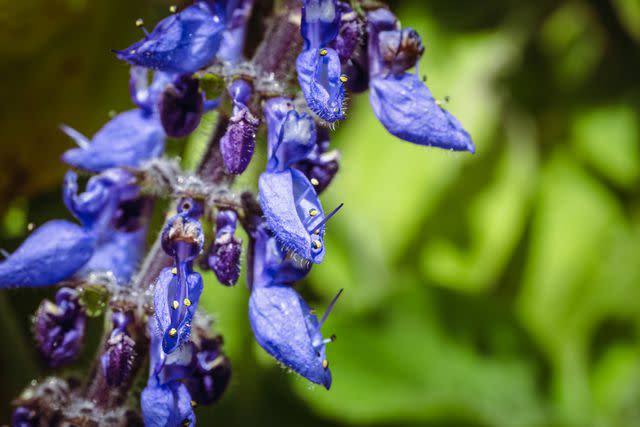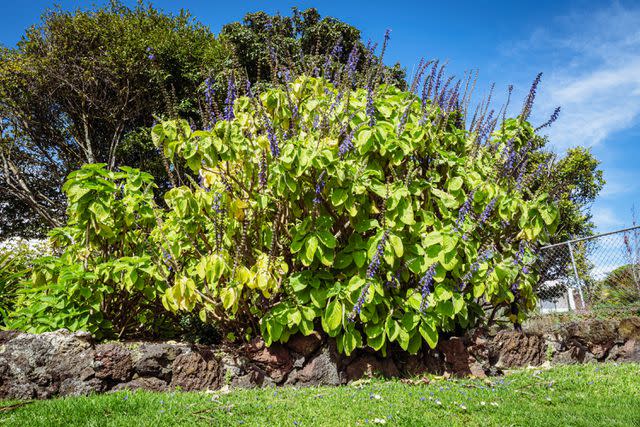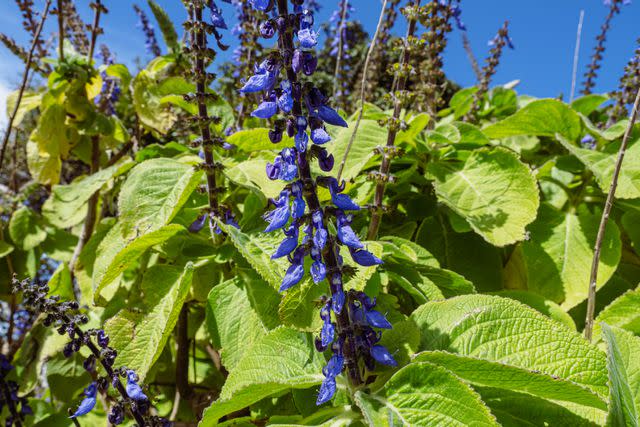How to Grow and Care for Blue Spur Flower

The Spruce / K. Dave
Reviewed by Julie Thompson-Adolf
Blue spur flower, also known as both Plectranthus barbatus and Coleus barbatus, has a large, upright bushy structure and blue-purple flowers, making this plant perfect for garden beds. This sizable species prefers partial sunlight, nutrient-rich soil, and warm temperatures, and it's fairly drought-tolerant.
Common Name | Blue spur flower, candlestick plant |
Botanical Name | Plectranthus barbatus, Coleus barbatus |
Family | Lamiaceae |
Plant Type | Perennial |
Mature Size | 5-8 ft. tall, 5-8 ft. wide |
Sun Exposure | Full, partial |
Soil Type | Moist but well-draining |
Soil pH | Neutral, acidic |
Bloom Time | Fall, winter, spring |
Flower Color | Blue, purple |
Hardiness Zones | 9-11 (USDA) |
Native Area | Africa |
Blue Spur Flower Care
Though it has vibrant blooms and a commanding presence, the blue spur flower is an easy-to-care-for addition to your garden. Here are the main care requirements for blue spur flower:
Choose a sunny spot, preferably with partial sunlight, though blue spur flower can tolerate full sun.
Prepare nutrient-dense, well-draining soil.
Water regularly but don't let the plant sit in wet soil for long.
Amend the soil with compost each year.

The Spruce / K. Dave

The Spruce / K. Dave

The Spruce / K. Dave
Light
Most blue spur flowers can tolerate full sun, but they prefer partial shade to really thrive. They are naturally found in forests or river banks with filtered light, so imitating this type of lighting will create the healthiest specimens.
For indoor lighting, place in an area with bright, indirect lighting for best results.
Soil
These vibrant flowers need rich soil like those found in the forest. Adding some organic matter or compost to your soil before planting will mimic this fertile environment. This will also help the soil to drain well and prevent problems with overwatering.
Water
The Plectranthus genus is drought-resistant and, therefore, not very picky when it comes to watering. A regular watering schedule is still beneficial but resist the urge to water it constantly.
If you live in a hot, dry climate, more watering may be needed to keep it healthy. However, be sure not to overwater, as this can quickly kill your plant. Water when the top inch of soil feels dry.
Temperature and Humidity
Consistent with its hardy nature, the blue spur flower can withstand a wide range of temperatures. It does well with heat and can also survive a frost.
As a tropical plant, a deep freeze will kill this plant though, so be sure to protect it if you have any harsh weather heading your way. One way to do this would be to bring your blue spur flower inside for the winter.
Fertilizer
Blue spur flower is quite hardy and does not require frequent fertilizing to maintain a full and healthy plant. Adding organic material and compost to the soil before planting will provide its nutrition needs. If you would like to encourage growth and flowering, a general fertilizer will do the job nicely.
Pruning
Blue spur flower spreads easily, so you'll want to prune it periodically throughout the growing season by simply pruning the tips to your liking. This will also ensure that your blue spur flower maintains an aesthetically pleasing shape.
Propagating Blue Spur Flower
The blue spur flower is an aggressive spreader. It does this by sending out offshoots under the soil. To propagate, you can simply dig up some of these offshoots and move the divided plant to its new area.
Another option for propagation is by using stem cuttings. The cuttings root easily in soil and can be grown without much hassle. Here’s how:
Using sharp garden snips or scissors, cut a section from your plant that is a few inches in length.
Remove the bottom leaves.
Place your cutting in damp soil. Keep moist while rooting.
Your new blue spur flower should take root rather quickly, and, before you know it, you will have another thriving plant.
Potting and Repotting
The blue spur flower does quite well in pots and can even be brought inside during harsh winters to be kept as a houseplant. If you would like to keep this plant in a pot, make sure you choose one with good drainage.
Since these plants are drought-tolerant, they do not like to sit in water. Too much water can quickly kill them. This makes drainage holes a must.
Overwintering
Blue spur flower can tolerate some cooler temperatures but will be killed by a hard freeze. In USDA zones that experience cold winters, you'll will have to bring blue spur flower indoors or simply treat it as an annual. In zones 9-11, blue spur flower should make it through winter without any additional help. It may die back significantly but should return in spring.
Common Plant Diseases
Fortunately, blue spur flower does not suffer from a lot of common plant diseases, but it can have fungal issues such as leaf spot. To avoid this, try not to let water sit on the leaves for long. This should not be much of a problem when growing outdoors, but preferably, water your blue spur flower in the morning just in case so that the leaves have time to try while the sun is shining.
How to Get Blue Spur Flower to Bloom
Blue spur flower is an easy bloomer that puts on a colorful show.
Bloom Months
Blue spur flower begins blooming in March in warm areas and continues to bloom up until the spring, possibly even summer.
What Do Blue Spur Flowers Look and Smell Like?
Blue spur flower plants send up stems full of small, blue-purple inflorescences in slight hook shapes. The flowers have no discernible smell.
How to Encourage More Blooms?
To encourage more blooms, make sure your blue spur flower plant is getting enough light and consider amending the soil around it with some fresh compost. You can also deadhead the flowers as appropriate to encourage the plant to send out more blooms.
Deadheading Blue Spur Flowers
Deadheading spent blue spur flowers will motivate the plant to send up even more blooms. By deadheading regularly, you may be able to get your blue spur flower plant to keep producing flowers into spring and even into summer.
Frequently Asked Questions
Do blue spur flowers like sun or shade?
Blue spur flower plants prefer a mixture of both. While they can tolerate full sun, they prefer partial sunlight, with a mixture of sun and shade throughout the day.
Is blue spur flower perennial?
Blue spur flower is a perennial but only in regions where it is hardy: USDA zones 9-11.
Do butterflies like blue spur flower?
Yes, butterflies tend to be drawn to the blue-purple flowers at the center of the blue spur flower plant.
Can you grow blue spur flower from a cutting?
Yes, taking a cutting is one of the main propagation methods for blue spur flower plants.
Read the original article on The Spruce.

